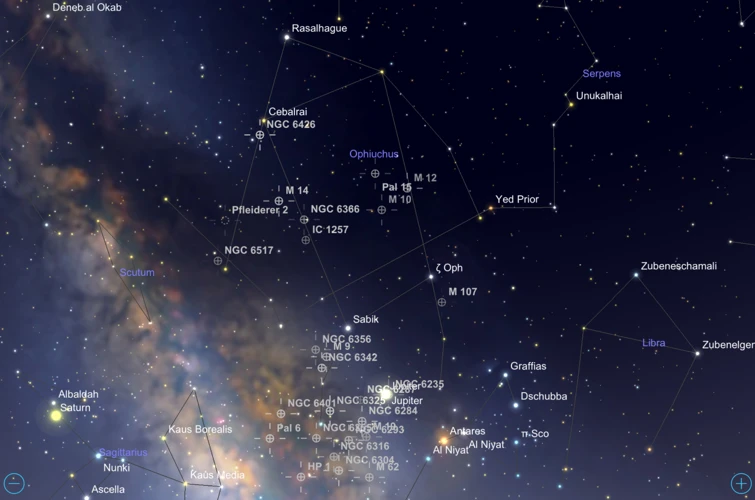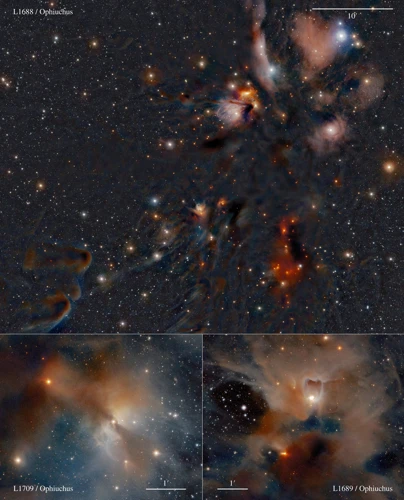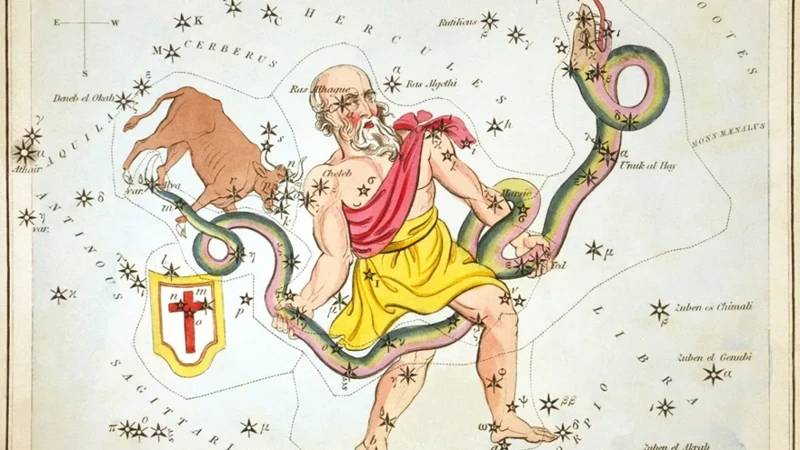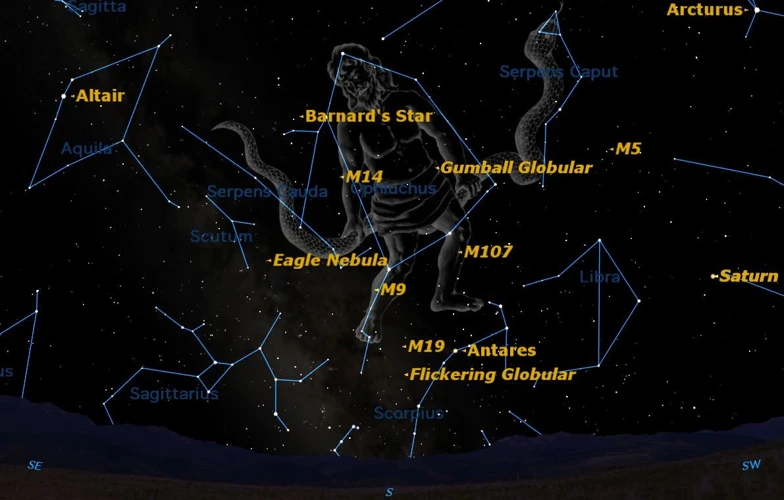The Pleiades Star Cluster has captivated the curiosity of astronomers and stargazers alike for centuries. Nestled within the Taurus constellation, this stellar cluster is shrouded in mystery and intrigue. Its celestial beauty and enigmatic history have sparked countless legends and scientific studies, as experts seek to unveil the secrets hidden within its glittering expanse. In this article, we will delve into the origin, composition, and historical significance of the Pleiades Star Cluster, explore modern observations and discoveries, unravel its mysteries and legends, and examine the current understanding and ongoing research surrounding this celestial wonder. Join us on a journey through the depths of the cosmos as we uncover the captivating secrets of the Pleiades Star Cluster.
Contents
- The Pleiades Star Cluster
- Historical Significance
- Modern Observations
- Mysteries and Legends
- Current Understanding and Research
- Conclusion
-
Frequently Asked Questions
- 1. What is the Pleiades Star Cluster?
- 2. How was the Pleiades Star Cluster formed?
- 3. How far away is the Pleiades Star Cluster?
- 4. How many stars are in the Pleiades Star Cluster?
- 5. How old is the Pleiades Star Cluster?
- 6. What is the significance of the Pleiades in mythology?
- 7. Can the Pleiades Star Cluster be seen with the naked eye?
- 8. Are there exoplanets in the Pleiades Star Cluster?
- 9. Can the Pleiades Star Cluster be seen year-round?
- 10. What role does the Pleiades Star Cluster play in astrology and zodiac?
- References
-
Frequently Asked Questions
- 1. What is the Pleiades Star Cluster?
- 2. How was the Pleiades Star Cluster formed?
- 3. How many stars are there in the Pleiades Star Cluster?
- 4. What is the significance of the Pleiades in mythology?
- 5. What observations did ancient civilizations make about the Pleiades?
- 6. What can modern telescopic observations tell us about the Pleiades?
- 7. What scientific research has been done on the Pleiades?
- 8. Is there a connection between the Pleiades and the Taurus constellation?
- 9. What is the “Seven Sisters Mystery” associated with the Pleiades?
- 10. How are the Pleiades being studied in terms of stellar evolution and exoplanet searches?
- References
- Read More
The Pleiades Star Cluster

The Pleiades Star Cluster, also known as the Seven Sisters, is a breathtaking collection of stars located in the Taurus constellation. This cluster is composed of hundreds of stars, with the brightest ones visibly shining on a clear night. The Pleiades Cluster has fascinated astronomers and stargazers for centuries due to its distinct appearance and cultural significance. Its formation and origin have long been a subject of study and speculation, and its composition and physical characteristics have been meticulously observed. According to scientific research, the stars within the Pleiades Cluster are relatively young, with an age of around 100 million years. They are mostly blue stars, although some are fainter or have different colors. The cluster is estimated to be about 444 light-years away from Earth, making it one of the closest star clusters to our planet. The Pleiades Star Cluster holds a prominent place in mythology and cultural traditions around the world, with stories and legends intricately woven into its celestial tapestry. These tales often involve themes of sisterhood, bravery, and love. Its significance is not limited to ancient civilizations and mythologies, as modern astronomers continue to unravel the mysteries hidden within its shimmering depths.
1. Origin and Formation
- The origin and formation of the Pleiades Star Cluster is a subject of scientific inquiry and speculation. Astronomers believe that the cluster came into existence around 100 million years ago as a result of the collapse of a giant molecular cloud. This cloud comprised interstellar gas and dust, which began to contract under the force of gravity. As the cloud collapsed, it fragmented into smaller clumps, one of which eventually formed the Pleiades Cluster.
- The process of star formation within the Pleiades Cluster began when these smaller clumps of gas and dust condensed further, forming dense protostellar cores. Eventually, nuclear fusion reactions ignited within these cores, giving birth to the young, hot stars that we see today. Stars in the Pleiades Cluster are still in their early stages of development, and their formation is ongoing.
- Interestingly, recent studies have found evidence of circumstellar disks around some stars within the Pleiades Cluster. These disks consist of gas and dust and are believed to be the precursors to the formation of planetary systems. The presence of these circumstellar disks indicates that planet formation may be occurring within the Pleiades Cluster, adding another layer of intrigue to its origin story.
- Scientists continue to study the origin and formation of the Pleiades Cluster using various methods, including spectroscopic observations and computer simulations. These investigations aim to provide a more detailed understanding of the formation mechanisms, dynamics, and evolution of the stars within the cluster.
The origin and formation of the Pleiades Star Cluster is a fascinating celestial phenomenon that continues to captivate scientists and stargazers alike. By unraveling the mysteries surrounding its birth, we can gain valuable insights into the processes that shape the universe around us. For more lesser-known constellation facts, explore our previous article on the topic.
2. Composition and Physical Characteristics
The Composition and Physical Characteristics of the Pleiades Star Cluster provide fascinating insights into the nature of this celestial wonder. The cluster is primarily composed of hot, young stars, with the brightest members classified as B-type main sequence stars. These stars are collectively referred to as the Seven Sisters, with their names derived from Greek mythology. The most prominent star in the cluster, Alcyone, shines with a magnitude of approximately 2.85. Surrounding these brightest stars are a multitude of fainter stars, estimated to be around 1,000 in total. These stars have different spectral types, including A-type, F-type, and G-type stars. The Pleiades Cluster is also known for its notorious nebula. The Pleiades Nebula, or Merope Nebula, is a reflection nebula that illuminates the surrounding interstellar dust, creating a beautiful blue glow. The cluster itself is embedded within this nebula, adding to its ethereal allure. The stars within the Pleiades Cluster are relatively young, with an estimated age of around 100 million years. They are believed to have formed from the same molecular cloud, and their proximity to one another gives the cluster its distinct appearance. The proximity of the stars in the Pleiades Cluster has allowed astronomers to study stellar evolution and other phenomena in great detail. By observing the cluster’s members, researchers have gained valuable insights into topics such as stellar rotation rates, magnetic activity, and circumstellar disks. The unique blend of stars within the Pleiades Cluster makes it a captivating subject of study for astronomers worldwide. Research and observations continue to shed light on this stunning and enigmatic cluster, deepening our understanding of the universe and our place within it. To learn more about lesser-known constellations, click here.
Historical Significance

The Historical Significance of the Pleiades Star Cluster stretches back millennia, with its presence deeply ingrained in mythology and cultural beliefs. Known as the Seven Sisters, this cluster has held different interpretations and names across various civilizations. In Greek mythology, the Pleiades were seven nymphs who caught the eye of the gods and were immortalized as stars in the sky, placed there by Zeus to protect them from the advances of Orion. These mythological tales serve as a reminder of the enduring power and influence of the night sky on human imagination. From Indigenous cultures to ancient civilizations such as the Maori, the Pleiades have played important roles in mythological constellation stories, symbolizing everything from fertility and agriculture to navigation and timekeeping. Even in modern times, the Pleiades continue to inspire awe and fascination, bridging the gap between ancient legends and astronomical research. To this day, stargazers around the world ponder the celestial wonders of the Pleiades and their connection to the history and traditions of humanity. The Pleiades Star Cluster continues to be a celestial tapestry that weaves together myth, cultural importance, and scientific understanding.
1. Mythology and Cultural Importance
Mythology and cultural importance surround the Pleiades Star Cluster, making it a celestial phenomenon deeply intertwined with human history. Across various cultures and civilizations, the Pleiades have been associated with captivating stories and legends. In Greek mythology, the cluster represents the seven daughters of Atlas and Pleione. According to the tale, the sisters were transformed into stars to escape the pursuit of the hunter Orion. The Pleiades’ cultural significance extends beyond Greece, with other civilizations attributing different names, meanings, and tales to these celestial jewels. In Native American cultures, the Pleiades are often referred to as the “Seven Sisters” and are associated with stories of creation, navigation, and seasonal changes. The Maori people of New Zealand have their own unique interpretation of this cluster, calling it “Matariki” and marking its appearance as the beginning of the new year. Stories and cultural traditions related to the Pleiades can be found worldwide, highlighting the universal fascination with the stars and their significance in our collective human imagination. To explore more mythological constellation stories, check out ourmythological constellation stories article.
2. Observations by Ancient Civilizations
Ancient civilizations across the world have gazed upon the Pleiades Star Cluster with wonder and awe, leaving a rich tapestry of observations and mythological interpretations. The Pleiades held significant cultural and spiritual importance for many ancient societies, with countless stories and legends woven into their existence. The cluster’s distinctive appearance, resembling a small cluster of stars or a tiny dipper, caught the attention of early civilizations and became a subject of fascination. The Babylonians referred to the Pleiades as “Mul.Mul,” meaning “The Star of Stars,” and considered them an important marker in their lunar calendar. The ancient Greeks, known for their astronomical studies, considered the Pleiades to be the seven daughters of Atlas and Pleione, giving rise to its alternate name, the Seven Sisters. The Pleiades played a central role in Greek mythology, with stories of love, tragedy, and transformation. In Japan, the cluster is known as “Subaru” and has cultural significance, symbolizing luck and harmony. Indigenous cultures in the Americas, such as the Lakota Sioux and the Mayans, also have ancient connections to the Pleiades, incorporating them into folklore and calendars. The Pleiades were often associated with agricultural cycles, providing guidance for planting and harvest. These observations by ancient civilizations demonstrate the enduring appeal and celestial significance of the Pleiades Star Cluster throughout human history. They serve as a testament to our innate curiosity and our deep connection to the mysteries of the cosmos. For those interested in exploring more about the role of constellations in ancient cultures, the article on the role of Ophiuchus in astrology and the zodiac provides fascinating insights into the celestial influences in various belief systems.
Modern Observations

Modern observations of the Pleiades Star Cluster have been facilitated by advanced telescopic technology and scientific research. Telescopes equipped with spectrographs have allowed astronomers to analyze the composition of the cluster’s stars in detail. These observations have revealed that the Pleiades Cluster is primarily made up of young, hot, and massive stars, with a few brown dwarfs and white dwarfs sprinkled among them. By studying the cluster’s stars, researchers have gained insight into stellar evolution and the formation of planetary systems. Extensive photometric observations have provided valuable data on the cluster’s age, distance, and motion. Scientists have also used these observations to discover protoplanetary disks and even exoplanets within the Pleiades Cluster. This ongoing research has shed light on the formation and evolution of stars, as well as the potential for planetary systems to arise within such stellar clusters. The Pleiades Star Cluster continues to be a subject of fascination and study, revealing new insights into the mysteries of our universe with each observation.
1. Telescopic Observations
Telescopic observations have played a crucial role in unraveling the secrets of the Pleiades Star Cluster. Powerful telescopes have allowed astronomers to peer deep into the heart of this celestial wonder, revealing a wealth of information about its individual stars and intricate structures. Here are some key findings from telescopic observations:
- Star Formation: Telescopic observations have provided valuable insights into the process of star formation within the Pleiades Cluster. Scientists have identified regions of ongoing star formation, where new stars are being born. These observations have helped refine our understanding of stellar evolution.
- Variability: Through careful monitoring and analysis, astronomers have discovered that certain stars in the Pleiades Cluster exhibit variability in their brightness. This variability can be attributed to a variety of factors, such as pulsations or interactions with nearby stars. Telescopic observations have allowed scientists to study these variations in detail, providing valuable clues about the nature and characteristics of the stars within the cluster.
- Brown Dwarfs: Telescopes have enabled the detection of faint and cool objects known as brown dwarfs within the Pleiades Cluster. These objects have masses between that of a planet and a star, and their discovery has challenged conventional understanding of stellar classification. Telescopic observations have helped astronomers identify and characterize these elusive objects in the cluster.
- Stellar Atmospheres: By analyzing the light emitted by the stars in the Pleiades Cluster, astronomers have been able to study the composition and properties of their atmospheres. Telescopic observations have revealed the presence of elements such as helium, hydrogen, and heavier metals in the stars, providing important clues about their formation and evolution.
These telescopic observations have greatly enhanced our knowledge of the Pleiades Star Cluster, shedding light on its stellar population, formation processes, and unique features. Continued advancements in telescope technology hold the promise of unraveling even more secrets and mysteries hidden within this mesmerizing celestial congregation.
2. Scientific Research and Discoveries
Scientific research and discoveries related to the Pleiades Star Cluster have provided valuable insights into its composition, evolution, and celestial phenomena. Astronomers have long been intrigued by this stellar cluster, and technological advancements have allowed for more detailed observations and analysis. One significant discovery is the presence of a dust disk around some of the stars in the Pleiades, indicating the potential for planetary formation. This finding has sparked further investigations into exoplanet searches within the cluster. Additionally, studies have revealed that the Pleiades Cluster is not a homogeneous group of stars, but rather a dynamic system with a range of ages and properties. This discovery has raised questions about the cluster’s origin and whether it formed from a single molecular cloud, or if it is a chance alignment of stars moving through space. Advancements in spectroscopy have enabled scientists to study the chemical composition of the stars within the cluster. Through these observations, researchers have identified trace elements and peculiarities in the spectra of some Pleiades stars, shedding light on their evolution and internal processes. The ongoing research and discoveries surrounding the Pleiades Star Cluster continue to unlock the secrets of this enigmatic celestial object, leading to a deeper understanding of stellar evolution and planetary systems.
Mysteries and Legends

The Pleiades Star Cluster is steeped in mysteries and legends that have been passed down through generations. One of the intriguing aspects of this celestial wonder is its connection to the constellation Taurus. In various mythological traditions, the Pleiades were often associated with a bull, symbolizing strength and fertility. This connection has sparked speculation about the significance of the cluster and its relation to the larger cosmic narrative. Additionally, the Pleiades have sparked a particular mystery known as the “Seven Sisters Mystery.” According to some Native American and Australian Aboriginal mythologies, there were originally seven stars in the cluster, but one has mysteriously disappeared. This legend has piqued the curiosity of astronomers and stargazers, prompting them to search for clues and explanations. While scientific research has shed light on many aspects of the Pleiades Star Cluster, these mysteries and legends continue to inspire wonder and fuel the human desire to uncover the secrets of the cosmos.
1. Taurus Connection
The Taurus Connection adds an intriguing layer of symbolism and mysticism to the Pleiades Star Cluster. Located within the constellation of Taurus, the Pleiades Cluster holds great significance in ancient mythology and cultural traditions. Taurus, the celestial bull, is often associated with strength, power, and fertility in various cultures. In Greek mythology, the bull represents Zeus, who transformed himself into a majestic white bull to carry Europa away. This connection between Taurus and the Pleiades can be seen in the story of the nymphs who make up the Seven Sisters. According to Greek mythology, the Pleiades were the daughters of Atlas and Pleione. They caught the eye of Orion, the great hunter, who relentlessly pursued them. In an act of protection, Zeus transformed the sisters into stars, placing them in the night sky. In this mythological narrative, the bull Taurus serves as a symbol of the sisters’ sanctuary and protection. This connection between Taurus and the Pleiades is not limited to Greek mythology but is also found in other cultures. In Indigenous Australian Dreamtime stories, the Pleiades are often associated with a group of women known as the Seven Sisters, who are pursued by a man represented by the constellation of Orion or Taurus. These tales emphasize the celestial bond between Taurus and the Pleiades, lending a sense of enchantment and wonder to the star cluster’s mystique. The Taurus Connection serves as a reminder of the rich cultural and mythological tapestry woven into the fabric of the Pleiades Star Cluster, making it a celestial wonder that transcends geographical and cultural boundaries.
2. The Seven Sisters Mystery
The Seven Sisters Mystery refers to the intriguing question surrounding the seventh star in the Pleiades Star Cluster. While the cluster is commonly referred to as the Seven Sisters, only six bright stars are easily visible to the naked eye. This has led to speculation and fascination about the missing seventh sister. Scientists have proposed several theories to explain this mystery. One theory suggests that the seventh star may have dimmed or disappeared entirely over time. Another theory posits that the seventh star is actually present but may be obscured by dust or other celestial phenomena, making it difficult to observe. Some astronomers believe that the seventh sister may have never actually existed and that it is purely a product of mythology and storytelling. Despite extensive telescopic observations and scientific research, the true nature of the missing seventh sister remains elusive. This enigmatic aspect of the Pleiades Cluster has captured the imagination of astronomers and continues to be a source of curiosity and speculation in the field of astronomy.
Current Understanding and Research

Current understanding and research surrounding the Pleiades Star Cluster is an ongoing endeavor that seeks to deepen our knowledge about these celestial wonders. Scientists have made significant progress in unraveling the mysteries of this cluster, particularly in the fields of stellar evolution and exoplanet searches. Stellar evolution studies focus on understanding the life cycle of stars within the Pleiades Cluster, exploring how they form, evolve, and eventually meet their end. By studying the various stages of stellar evolution, researchers gain valuable insights into the formation and dynamics of star clusters as a whole. The Pleiades Cluster has served as a prime target for exoplanet searches. Observations have revealed the presence of planetary systems within this cluster, opening up exciting possibilities for the study of exoplanet formation and habitability. The identification and characterization of exoplanets within the Pleiades Cluster offer valuable opportunities for studying planetary systems in a relatively young and dynamic environment. As scientific advancements continue to unfold, our understanding of the Pleiades Star Cluster will undoubtedly expand, shedding even more light on its intriguing secrets and paving the way for further astronomical discoveries.
1. Stellar Evolution
Stellar evolution, the process by which stars undergo changes over time, is a fascinating field of study that sheds light on the life cycle of stars within the Pleiades Star Cluster. Here are some key aspects of stellar evolution within the cluster:
1. Main Sequence Stars: The majority of stars within the Pleiades Cluster are currently in the main sequence phase of their evolution. These stars, including the bright blue ones, are actively fusing hydrogen into helium in their cores, creating the energy that allows them to shine brightly. They are stable and will continue in this phase for millions or even billions of years.
2. Stellar Lifespan: The lifespan of a star in the Pleiades Cluster depends on its mass. Higher-mass stars, known as O-type and B-type stars, have shorter lifespans compared to lower-mass stars. These massive stars exhaust their hydrogen fuel more rapidly, resulting in a relatively brief existence of a few million years.
3. Stellar Death: All stars eventually exhaust their nuclear fuel and enter the later stages of their evolution. For lower-mass stars in the Pleiades Cluster, this will be followed by a transformation into a red giant. These stars will expand and become cooler as they burn through their remaining fuel, eventually shedding their outer layers into space.
4. White Dwarfs: Stars with lower mass, including those in the Pleiades Cluster, undergo a transformation into a white dwarf after their red giant phase. A white dwarf is a dense, hot remnant composed mostly of carbon and oxygen. These stellar remnants slowly cool down over billions of years, eventually becoming a cold, dark object known as a black dwarf.
5. Stellar Interactions: Within the Pleiades Cluster, stellar interactions can occur, affecting the evolution of its stars. Close encounters or binary star systems can lead to the exchange of mass between stars, altering their evolution paths. These interactions can also result in the formation of exotic objects such as neutron stars or even supernovae, which can have a significant impact on the surrounding area.
The study of stellar evolution within the Pleiades Star Cluster provides valuable insights into the processes that shape the lives and ultimate fates of these celestial objects. By examining the different stages and outcomes of stellar evolution, scientists can deepen their understanding of the universe and the intricate mechanisms responsible for the birth, life, and death of stars.
2. Exoplanet Searches
Exoplanet searches have become a major area of focus for astronomers studying the Pleiades Star Cluster. The presence of exoplanets, or planets outside of our solar system, within this cluster has long been a subject of intrigue. In recent years, advanced telescopes and observational techniques have allowed scientists to detect and study exoplanets in other star systems, including those within the Pleiades Cluster. These discoveries have provided valuable insights into the formation and evolution of planetary systems. Researchers have employed various methods to detect exoplanets, such as the transit method, which looks for subtle dips in a star’s brightness caused by a planet passing in front of it. Another method is the radial velocity technique, which measures the tiny wobbles in a star’s motion caused by the gravitational pull of orbiting planets. These advancements in exoplanet research have yielded exciting findings within the Pleiades Cluster, including the detection of planets ranging from Neptune-like gas giants to smaller rocky planets resembling our own Earth. The exploration of exoplanets in the Pleiades Cluster offers a unique opportunity to understand the diversity and dynamics of planetary systems beyond our own. Continued research in this field will undoubtedly uncover more secrets and expand our understanding of the Pleiades Star Cluster’s exoplanetary population.
Conclusion

In conclusion, the Pleiades Star Cluster remains a captivating and enigmatic celestial wonder. Throughout history, it has stirred the imagination of humans, inspiring both mythological tales and scientific exploration. From its ancient origins and cultural significance to its modern observations and scientific discoveries, the Pleiades Cluster continues to unlock the secrets of stellar evolution and exoplanet searches. While many mysteries and legends still surround this cluster, advancements in telescopic observations and ongoing research hold promise for unraveling its full story. As astronomers continue to explore the depths of the cosmos, the Pleiades Star Cluster will undoubtedly continue to be a source of fascination and inspiration. Whether through its undeniable beauty or its scientific significance, the Pleiades Cluster brings us closer to understanding the vastness and complexity of our universe. Let us marvel at the brilliance of these celestial jewels, and may the mysteries of the Pleiades Cluster ignite our curiosity for generations to come.
Frequently Asked Questions

1. What is the Pleiades Star Cluster?
The Pleiades Star Cluster is a remarkable collection of stars located in the Taurus constellation. It is also known as the Seven Sisters due to its distinct cluster of bright stars.
2. How was the Pleiades Star Cluster formed?
The Pleiades Star Cluster formed from a collapsing cloud of gas and dust in space. Gravitational forces caused the material to come together, leading to the birth of these mesmerizing stars.
3. How far away is the Pleiades Star Cluster?
The Pleiades Star Cluster is estimated to be approximately 444 light-years away from Earth, making it one of the closest star clusters to our planet.
4. How many stars are in the Pleiades Star Cluster?
The Pleiades Star Cluster is composed of hundreds of stars. However, only a few of them are easily visible to the naked eye, with the brightest and most prominent being known as the Seven Sisters.
5. How old is the Pleiades Star Cluster?
The Pleiades Star Cluster is relatively young compared to other star clusters. It is estimated to be about 100 million years old, which is considered young in astronomical terms.
6. What is the significance of the Pleiades in mythology?
The Pleiades Star Cluster holds great mythological significance across various cultures. It has been associated with stories of sisterhood, love, and bravery in Greek, Native American, and other ancient mythologies.
7. Can the Pleiades Star Cluster be seen with the naked eye?
Yes, the Pleiades Star Cluster can be seen with the naked eye. On a clear night, its bright stars form a distinct pattern in the sky, making it a popular target for stargazers and astronomy enthusiasts.
8. Are there exoplanets in the Pleiades Star Cluster?
While exoplanets have been discovered in other star clusters, no confirmed exoplanets have been detected within the Pleiades Star Cluster as of yet. However, ongoing research continues to explore this possibility.
9. Can the Pleiades Star Cluster be seen year-round?
Yes, the Pleiades Star Cluster can be seen from both hemispheres and is visible all year round. However, its prominence and visibility may vary depending on the season and atmospheric conditions.
10. What role does the Pleiades Star Cluster play in astrology and zodiac?
The Pleiades Star Cluster has significance in astrology, particularly within the constellation of Taurus. It is considered a celestial marker and holds symbolic value for those who follow astrological beliefs.
References
- A Constellation of Cultural Connections
- How to Observe and Photograph the Pleiades (M45) ?
- The Pleiades: A Picture in 1000 Words
Frequently Asked Questions

1. What is the Pleiades Star Cluster?
The Pleiades Star Cluster, also known as the Seven Sisters, is a group of stars located in the constellation of Taurus. It is one of the closest star clusters to Earth and is visible to the naked eye.
2. How was the Pleiades Star Cluster formed?
The exact formation process of the Pleiades Star Cluster is still a subject of scientific study. It is believed that the stars in the cluster formed together from a single molecular cloud around 100 million years ago.
3. How many stars are there in the Pleiades Star Cluster?
The Pleiades Star Cluster is composed of hundreds of stars, but only a few of them are easily visible to the naked eye. Astronomers estimate that there are about 1,000 stars in the cluster in total.
4. What is the significance of the Pleiades in mythology?
The Pleiades have great mythological significance in various cultures around the world. They are often associated with legends of celestial maidens and have been mentioned in stories from ancient Greek, Native American, and Indigenous Australian cultures, among others.
5. What observations did ancient civilizations make about the Pleiades?
Ancient civilizations had a keen interest in the Pleiades and made various observations about them. For example, the Maya used the position of the Pleiades to determine the timing of important events, while the ancient Greeks used them to mark the beginning and end of their agricultural season.
6. What can modern telescopic observations tell us about the Pleiades?
Modern telescopes allow astronomers to study the Pleiades in great detail. They have provided insights into the cluster’s age, composition, and the presence of dust and gas around the stars. Telescopes also help measure the distances between the stars in the cluster.
7. What scientific research has been done on the Pleiades?
Scientists have conducted extensive research on the Pleiades Star Cluster. They have studied its stars to understand stellar evolution, conducted spectroscopic analysis to determine the chemical composition of the stars, and searched for exoplanets within the cluster.
8. Is there a connection between the Pleiades and the Taurus constellation?
Yes, the Pleiades Star Cluster is located within the boundaries of the Taurus constellation. Both the cluster and the constellation are often mentioned together in astronomical discussions and observations.
9. What is the “Seven Sisters Mystery” associated with the Pleiades?
The “Seven Sisters Mystery” refers to the long-standing question of why, despite being easily visible to the naked eye, most people can only perceive six stars in the Pleiades. Various explanations have been proposed, including the possibility of missing stars or differences in visual acuity among individuals.
10. How are the Pleiades being studied in terms of stellar evolution and exoplanet searches?
Scientists study the Pleiades to better understand how stars evolve over time. By observing the different stages of stellar evolution within the cluster, they can gain insights into the life cycle of stars. Additionally, researchers have searched for exoplanets within the Pleiades to expand our knowledge of planetary systems beyond our own.







